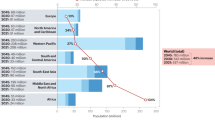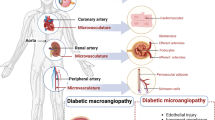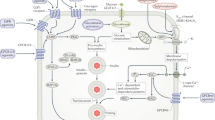Abstract
Insulin-resistance syndromes are of pandemic proportions; 150 million people worldwide and an estimated 43 million people in the US are currently affected by type 2 diabetes mellitus or metabolic syndrome respectively. Treatment of heart disease in the context of type 2 diabetes requires multifactorial risk-factor management, including lifestyle modification and drug treatment for comorbidities. Management of coronary risk extends beyond simple cholesterol lowering. Early use of cardiac imaging and, where appropriate, revascularization should be considered in high-risk or symptomatic patients. Traditionally, patients with type 2 diabetes and coronary arterial disease have been treated surgically, but percutaneous revascularization of these patients is increasingly common. Indeed, revascularization by use of drug-eluting coronary stents combined with administration of novel antiplatelet agents has revolutionized percutaneous coronary intervention in patients with type 2 diabetes. Despite these advances, there is no consensus of opinion regarding revascularization strategies or risk-factor management in insulin-resistant patients with symptomatic or prognostically important coronary arterial disease. Furthermore, specific therapies and preventative strategies for diabetic cardiomyopathy and heart failure in patients with type 2 diabetes remain elusive. The identification of optimized approaches for the prevention and treatment of the metabolic syndrome and heart disease in insulin-resistant, nondiabetic patients remains a major global challenge.
This is a preview of subscription content, access via your institution
Access options
Subscribe to this journal
Receive 12 print issues and online access
$209.00 per year
only $17.42 per issue
Buy this article
- Purchase on Springer Link
- Instant access to full article PDF
Prices may be subject to local taxes which are calculated during checkout

Similar content being viewed by others
References
Reaven GM (1988) Banting lecture. Role of insulin resistance in human disease. Diabetes 37: 1595–1607
Lorenzo C et al. (2003) The metabolic syndrome as predictor of type 2 diabetes: the San Antonio heart study. Diabetes Care 26: 3153–3159
Zimmet P et al. (2001) Global and societal implications of the diabetes epidemic. Nature 414: 782–787
Ford ES et al. (2002) Prevalence of the metabolic syndrome among US adults: findings from the third National Health and Nutrition Examination Survey. JAMA 287: 356–359
Ninomiya JK et al. (2004) Association of the metabolic syndrome with history of myocardial infarction and stroke in the Third National Health and Nutrition Examination Survey. Circulation 109: 42–46
Nathan DM et al. (1997) The epidemiology of cardiovascular disease in type 2 diabetes mellitus: how sweet it is ... or is it? Lancet 350 (Suppl 1): SI4–SI9
Grundy SM et al. (1999) Diabetes and cardiovascular disease: a statement for healthcare professionals from the American Heart Association. Circulation 100: 1134–1146
Kannel WB and McGee DL (1979) Diabetes and cardiovascular disease. The Framingham study. JAMA 241: 2035–2038
Bergman RN et al. (1979) Quantitative estimation of insulin sensitivity. Am J Physiol 236: E667–E677
Matthews DR et al. (1985) Homeostasis model assessment: insulin resistance and beta-cell function from fasting plasma glucose and insulin concentrations in man. Diabetologia 28: 412–419
DeFronzo RA (1988) 1987 Lilly lecture. The triumvirate: beta-cell, muscle, liver. A collusion responsible for NIDDM. Diabetes 37: 667–687
Shulman GI (2000) Cellular mechanisms of insulin resistance. J Clin Invest 106: 171–176
Randle PJ et al. (1963) The glucose fatty-acid cycle. Its role in insulin sensitivity and the metabolic disturbances of diabetes mellitus. Lancet 1: 785–789
Aitman TJ et al. (1997) Defects of insulin action on fatty acid and carbohydrate metabolism in familial combined hyperlipidemia. Arterioscler Thromb Vasc Biol 17: 748–754
Paternostro G et al. (1996) Cardiac and skeletal muscle insulin resistance in patients with coronary heart disease. A study with positron emission tomography. J Clin Invest 98: 2094–2099
Schumacher MC et al. (1992) Major gene effect for insulin levels in familial NIDDM pedigrees. Diabetes 41: 416–423
Shoulders CC et al. (2004) Genetics of familial combined hyperlipidemia and risk of coronary heart disease. Hum Mol Genet 13 (Spec 1): R149–R160
Aitman TJ and Todd JA (1995) Molecular genetics of diabetes mellitus. Baillieres Clin Endocrinol Metab 9: 631–656
Stern MP (2000) Strategies and prospects for finding insulin resistance genes. J Clin Invest 106: 323–327
Kahn BB and Flier JS (2000) Obesity and insulin resistance. J Clin Invest 106: 473–481
Grundy SM et al. (2004) Definition of metabolic syndrome: Report of the National Heart, Lung, and Blood Institute/American Heart Association conference on scientific issues related to definition. Circulation 109: 433–438
Haffner SM et al. (1998) Mortality from coronary heart disease in subjects with type 2 diabetes and in nondiabetic subjects with and without prior myocardial infarction. N Engl J Med 339: 229–234
James RW (2001) Diabetes and other coronary heart disease risk equivalents. Curr Opin Lipidol 12: 425–431
Thrainsdottir IS et al. (2005) The association between glucose abnormalities and heart failure in the population-based reykjavik study. Diabetes Care 28: 612–616
Bauters C et al. (2003) Influence of diabetes mellitus on heart failure risk and outcome. Cardiovasc Diabetol 2: 1
Creager MA et al. (2003) Diabetes and vascular disease: pathophysiology, clinical consequences, and medical therapy: Part I. Circulation 108: 1527–1532
Young ME et al. (2002) Adaptation and maladaptation of the heart in diabetes: Part II: potential mechanisms. Circulation 105: 1861–1870
Nitenberg A et al. (2002) Coronary microvascular adaptation to myocardial metabolic demand can be restored by inhibition of iron-catalyzed formation of oxygen free radicals in type 2 diabetic patients. Diabetes 51: 813–818
Rutter MK et al. (2003) Impact of glucose intolerance and insulin resistance on cardiac structure and function: sex-related differences in the Framingham Heart Study. Circulation 107: 448–454
Rubler S et al. (1972) New type of cardiomyopathy associated with diabetic glomerulosclerosis. Am J Cardiol 30: 595–602
Taegtmeyer H et al. (2002) Adaptation and maladaptation of the heart in diabetes: Part I: general concepts. Circulation 105: 1727–1733
Mizushige K et al. (2000) Alteration in left ventricular diastolic filling and accumulation of myocardial collagen at insulin-resistant prediabetic stage of a type II diabetic rat model. Circulation 101: 899–907
(online 31 March 2005) Department of Health [http://www.dh.gov.uk] (accessed 31 March 2005)
Tuomilehto J et al. (2001) Prevention of type 2 diabetes mellitus by changes in lifestyle among subjects with impaired glucose tolerance. N Engl J Med 344: 1343–1350
Knowler WC et al. (2002) Reduction in the incidence of type 2 diabetes with lifestyle intervention or metformin. Diabetes Prevention Program Research Group. N Engl J Med 346: 393–403
Heart Outcomes Prevention Evaluation Study Investigators (2000) Effects of ramipril on cardiovascular and microvascular outcomes in people with diabetes mellitus: results of the HOPE study and MICRO-HOPE substudy. Lancet 355: 253–259
Hansson L et al. (1998) Effects of intensive blood-pressure lowering and low-dose aspirin in patients with hypertension: principal results of the Hypertension Optimal Treatment (HOT) randomised trial. HOT Study Group. Lancet 351: 1755–1762
UK Prospective Diabetes Study (UKPDS) Group (1998) Intensive blood-glucose control with sulphonylureas or insulin compared with conventional treatment and risk of complications in patients with type 2 diabetes (UKPDS 33). Lancet 352: 837–853
Williams B et al. (2004) Guidelines for management of hypertension: report of the fourth working party of the British Hypertension Society, 2004-BHS IV. J Hum Hypertens 18: 139–185
Steinmetz A et al. (2001) Treatment of dyslipoproteinemia in the metabolic syndrome. Exp Clin Endocrinol Diabetes 109: S548–S559
Steiner G (2000) Lipid intervention trials in diabetes. Diabetes Care 23 (Suppl 2): B49–B53
Colhoun HM et al. (2004) Primary prevention of cardiovascular disease with atorvastatin in type 2 diabetes in the Collaborative Atorvastatin Diabetes Study (CARDS): multicentre randomised placebo-controlled trial. Lancet 364: 685–696
Bays H (2002) Existing and investigational combination drug therapy for high-density lipoprotein cholesterol. Am J Cardiol 90: 30K–43K
Rubins HB et al. (1999) Gemfibrozil for the secondary prevention of coronary heart disease in men with low levels of high-density lipoprotein cholesterol. Veterans Affairs High-Density Lipoprotein Cholesterol Intervention Trial Study Group. N Engl J Med 341: 410–418
Robins SJ et al. (2003) Insulin resistance and cardiovascular events with low HDL cholesterol: The Veterans Affairs HDL Intervention Trial (VA-HIT) Diabetes Care 26: 1513–1517
Brown BG et al. (2001) Simvastatin and niacin, antioxidant vitamins, or the combination for the prevention of coronary disease. N Engl J Med 345: 1583–1592
Garg A and Grundy SM (1990) Nicotinic acid as therapy for dyslipidemia in non-insulin-dependent diabetes mellitus. JAMA 264: 723–726
Brousseau ME et al. (2004) Effects of an inhibitor of cholesteryl ester transfer protein on HDL cholesterol. N Engl J Med 350: 1505–1515
Krentz AJ and Bailey CJ (2005) Oral antidiabetic agents: current role in type 2 diabetes mellitus. Drugs 65: 385–411
UK Prospective Diabetes Study (UKPDS) Group (1998) Effect of intensive blood-glucose control with metformin on complications in overweight patients with type 2 diabetes (UKPDS 34). Lancet 352: 854–865
Chiasson JL et al. (2003) Acarbose treatment and the risk of cardiovascular disease and hypertension in patients with impaired glucose tolerance: The STOP-NIDDM Trial. JAMA 290: 486–494
Hallsten K et al. (2004) Enhancement of insulin-stimulated myocardial glucose uptake in patients with Type 2 diabetes treated with rosiglitazone. Diabet Med 21: 1280–1287
Zuckerman SH et al. (2002) Peroxisome proliferator-activated receptor alpha, gamma coagonist LY465608 inhibits macrophage activation and atherosclerosis in apolipoprotein E knockout mice. Lipids 37: 487–494
BARI1 (1996) Comparison of coronary bypass surgery with angioplasty in patients with multivessel disease. The Bypass Angioplasty Revascularization Investigation (BARI) Investigators. N Engl J Med 335: 217–225
Beatt KJ et al. (2004) Revascularisation in diabetics with multivessel coronary artery disease. Heart 90: 999–1002
Leon MB and Bakhai A (2003) Drug-eluting stents and glycoprotein IIb/IIIa inhibitors: combination therapy for the future. Am Heart J 146 (Suppl): S13–S17
Kapur A et al. (2005) The Coronary Artery Revascularisation in Diabetes (CARDia) trial: background, aims, and design. Am Heart J 149: 13–19
Sobel BE et al. (2003) Burgeoning dilemmas in the management of diabetes and cardiovascular disease: rationale for the Bypass Angioplasty Revascularization Investigation 2 Diabetes (BARI 2D) Trial. Circulation 107: 636–642
Marso SP et al. (2003) Diabetes mellitus is associated with a shift in the temporal risk profile of in-hospital death after percutaneous coronary intervention: an analysis of 25,223 patients over 20 years. Am Heart J 145: 270–277
Miettinen H et al. (1998) Impact of diabetes on mortality after the first myocardial infarction. The FINMONICA Myocardial Infarction Register Study Group. Diabetes Care 21: 69–75
Bartnik M et al. (2004) Newly detected abnormal glucose tolerance: an important predictor of long-term outcome after myocardial infarction. Eur Heart J 25: 1990–1997
Malmberg K et al. (1995) Randomized trial of insulin-glucose infusion followed by subcutaneous insulin treatment in diabetic patients with acute myocardial infarction (DIGAMI study): effects on mortality at 1 year. J Am Coll Cardiol 26: 57–65
Malmberg K et al. (2005) Intense metabolic control by means of insulin in patients with diabetes mellitus and acute myocardial infarction (DIGAMI 2): effects on mortality and morbidity. Eur Heart J 26: 650–661
Keeley EC et al. (2003) Primary angioplasty versus intravenous thrombolytic therapy for acute myocardial infarction: a quantitative review of 23 randomised trials. Lancet 361: 13–20
Underwood SR et al. (2004) Imaging techniques for the assessment of myocardial hibernation. Report of a Study Group of the European Society of Cardiology. Eur Heart J 25: 815–836
Fonarow GC (2004) Managing the patient with diabetes mellitus and heart failure: issues and considerations. Am J Med 116 (Suppl 5A): 76S–88S
Shekelle PG et al. (2003) Efficacy of angiotensin-converting enzyme inhibitors and beta-blockers in the management of left ventricular systolic dysfunction according to race, gender, and diabetic status: a meta-analysis of major clinical trials. J Am Coll Cardiol 41: 1529–1538
Packer M et al. (2001) Effect of carvedilol on survival in severe chronic heart failure. N Engl J Med 344: 1651–1658
Alberti KG and Zimmet PZ (1998) Definition, diagnosis and classification of diabetes mellitus and its complications. Part 1: diagnosis and classification of diabetes mellitus provisional report of a WHO consultation. Diabet Med 15: 539–553
Acknowledgements
The authors are supported by grants from the UK Department of Health, the Medical Research Council, the Wellcome Trust and the British Heart Foundation.
Author information
Authors and Affiliations
Corresponding author
Ethics declarations
Competing interests
The authors declare no competing financial interests.
Glossary
- EUGLYCEMIC CLAMP TECHNIQUE
-
Insulin is infused at a constant rate and glucose titrated to a preset level. Insulin resistance is measured when a steady state is reached
- HOMEOSTATIC MODEL ASSESSMENT
-
Uses fasting blood levels of insulin and glucose to model insulin resistance and β-cell function
- MINIMAL MODEL ANALYSIS
-
Profiles of insulin and glucose concentrations after an intravenous glucose bolus are used to estimate insulin resistance and β-cell function by curve fitting
- ORAL GLUCOSE TOLERANCE TEST
-
Plasma glucose levels are measured after oral consumption of 75 g anhydrous glucose in 250–300 ml of water. Raised glucose levels indicate impaired glucose tolerance
- ADIPOKINES
-
Small proteins secreted from adipocytes which act on peripheral tissues to induce receptor-mediated activation of cellular signaling
Rights and permissions
About this article
Cite this article
Cook, S., Aitman, T. & Naoumova, R. Therapy Insight: heart disease and the insulin-resistant patient. Nat Rev Cardiol 2, 252–260 (2005). https://doi.org/10.1038/ncpcardio0194
Received:
Accepted:
Issue Date:
DOI: https://doi.org/10.1038/ncpcardio0194
This article is cited by
-
Age-related insulin resistance in hypothalamus and peripheral tissues of orexin knockout mice
Diabetologia (2008)
-
Should patients with type 2 diabetes asymptomatic for coronary artery disease undergo testing for myocardial ischemia?
Nature Clinical Practice Cardiovascular Medicine (2005)



